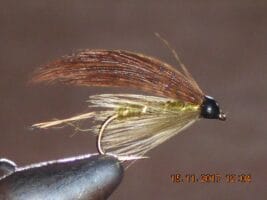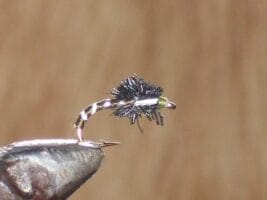Your cart is currently empty!
Endrick Spider Fly
Master Traditional Wet Fly Fishing Introducing the Endrick Spider Fly, a classic pattern that embodies the essence of traditional wet fly fishing. Originally developed for sea trout and salmon on Scotland’s River Endrick, this versatile pattern has evolved into an essential fly for all species of trout and challenging conditions. Each fly is meticulously crafted…
Description
Master Traditional Wet Fly Fishing
Introducing the Endrick Spider Fly, a classic pattern that embodies the essence of traditional wet fly fishing. Originally developed for sea trout and salmon on Scotland’s River Endrick, this versatile pattern has evolved into an essential fly for all species of trout and challenging conditions. Each fly is meticulously crafted following time-honored tying techniques, featuring a distinctive pheasant tail body and soft hackle that creates an irresistible presentation in the water. The sparse, suggestive design imitates a wide range of aquatic insects, making it particularly effective during specific hatches and as a searching pattern throughout the season.
Premium Materials and Traditional Construction
Every Endrick Spider Fly showcases exceptional quality through carefully selected components:
- Premium quality pheasant tail fibers
- Selected partridge hackle feathers
- High-grade tying thread
- Optional copper wire ribbing
- Precise proportions throughout
- Traditional hook selection
- Quality-tested materials
- Enhanced durability features
- Natural color patterns
- Classic design elements
- Size-specific materials
- Proven construction
- Durable finishes
- Traditional appeal
Technical Specifications:
- Hook: Traditional wet fly (sizes 10-18)
- Thread: Brown 6/0
- Body: Pheasant tail fibers
- Rib: Fine copper wire (optional)
- Hackle: Premium partridge
- Tail: Pheasant tail fibers
- Profile: Traditional spider
- Movement: Soft and natural
- Sink Rate: Controlled descent
- Durability: Enhanced construction
Advanced Fishing Applications
Traditional Wet Fly Techniques:
- Down-and-across presentation
- Upstream wet fly
- Wet fly swing
- Dead drift approaches
- Cross-current fishing
- Downstream presentation
- Team of three setup
- Multiple fly rigs
- Structure fishing
- Current seam tactics
Water Type Adaptations:
- Fast-flowing rivers
- Slow-moving streams
- Spring creeks
- Tailwaters
- Mountain streams
- Lowland rivers
- Still waters
- Small brooks
- Large rivers
- Mixed waters
Seasonal Strategies
Spring Tactics:
- Early season approaches
- Hatching periods
- Water temperature considerations
- Color selection
- Size adaptation
- Depth control
- Presentation speed
- Pattern matching
- Water reading
- Strike detection
Summer Applications:
- Morning hatches
- Evening rises
- Deep runs
- Shallow riffles
- Light considerations
- Temperature factors
- Pressure adaptation
- Pattern selection
- Timing strategies
- Multiple presentations
Fall Patterns:
- Pre-winter feeding
- Late season hatches
- Water temperature
- Light conditions
- Depth variations
- Color choices
- Size selection
- Presentation styles
- Weather factors
- Feeding windows
Winter Techniques:
- Deep water approaches
- Slow presentations
- Temperature factors
- Limited feeding periods
- Modified swings
- Depth control
- Size choices
- Color adaptation
- Timing considerations
- Pattern selection
Specific Fishing Methods
Traditional Approaches:
- Classic wet fly swing
- Down-and-across
- Upstream wet
- Team of three
- Point fly tactics
- Dropper techniques
- Multiple fly rigs
- Structure fishing
- Current seam
- Edge water
Modern Adaptations:
- Indicator nymphing
- Euro-style approaches
- Short-line techniques
- Deep presentation
- Fast water tactics
- Slow water methods
- Mixed techniques
- Contemporary rigs
- Modified presentations
- Hybrid approaches
Species-Specific Success
Primary Targets:
- Brown Trout
- Rainbow Trout
- Brook Trout
- Sea Trout
- Atlantic Salmon
- Grayling
- Mountain Whitefish
- Arctic Char
- Pacific Salmon
- Various species
Feeding Behaviors:
- Active pursuit
- Passive feeding
- Opportunistic takes
- Selective feeding
- Surface activity
- Subsurface feeding
- Migration patterns
- Spawning behavior
- Territorial response
- Competitive feeding
Technical Rigging Considerations
Leader Setup:
- Traditional wet fly
- Modern adaptations
- Tippet selection
- Length considerations
- Material choices
- Knot selection
- Breaking strength
- Visibility factors
- Sink rates
- Leader design
Terminal Tackle:
- Dropper setup
- Team arrangement
- Pattern spacing
- Weight distribution
- Line control
- Strike detection
- Depth adjustment
- Drift control
- Swing speed
- Presentation angle
Environmental Adaptations
Water Clarity:
- Crystal clear conditions
- Slightly colored water
- Stained situations
- Post-rain tactics
- Spring runoff
- Summer clarity
- Fall conditions
- Winter water
- Changing conditions
- Light penetration
Weather Conditions:
- Bright sunlight
- Overcast days
- Early morning
- Late evening
- Cloudy conditions
- Rain situations
- Low light periods
- Changing light
- Shadow effects
- Barometric pressure
Care and Maintenance?Storage:
- Proper drying methods
- Moisture control
- UV protection
- Temperature considerations
- Box selection
- Organization systems
- Material preservation
- Hook protection
- Pattern separation
- Quality maintenance
Regular Maintenance:
- Hackle inspection
- Material assessment
- Hook point verification
- Profile evaluation
- Performance testing
- Replacement timing
- Cleaning procedures
- Repair techniques
- Quality control
- Pattern rotation
The Endrick Spider Fly represents the perfect fusion of traditional design and proven effectiveness. Its carefully selected materials and time-honored construction ensure consistent performance across various fishing conditions. Whether you’re targeting selective trout during specific hatches or searching for aggressive feeders in challenging conditions, this classic pattern provides the perfect tool for traditional wet fly success.
Additional information
| Hook size | 10, 12, 14, 16, 18, 20 |
|---|---|
| Hook type | Barbed Hooks, Barbless Hooks |







